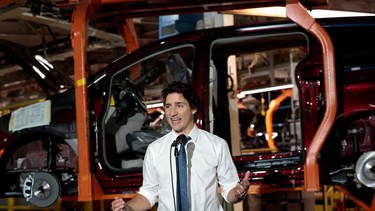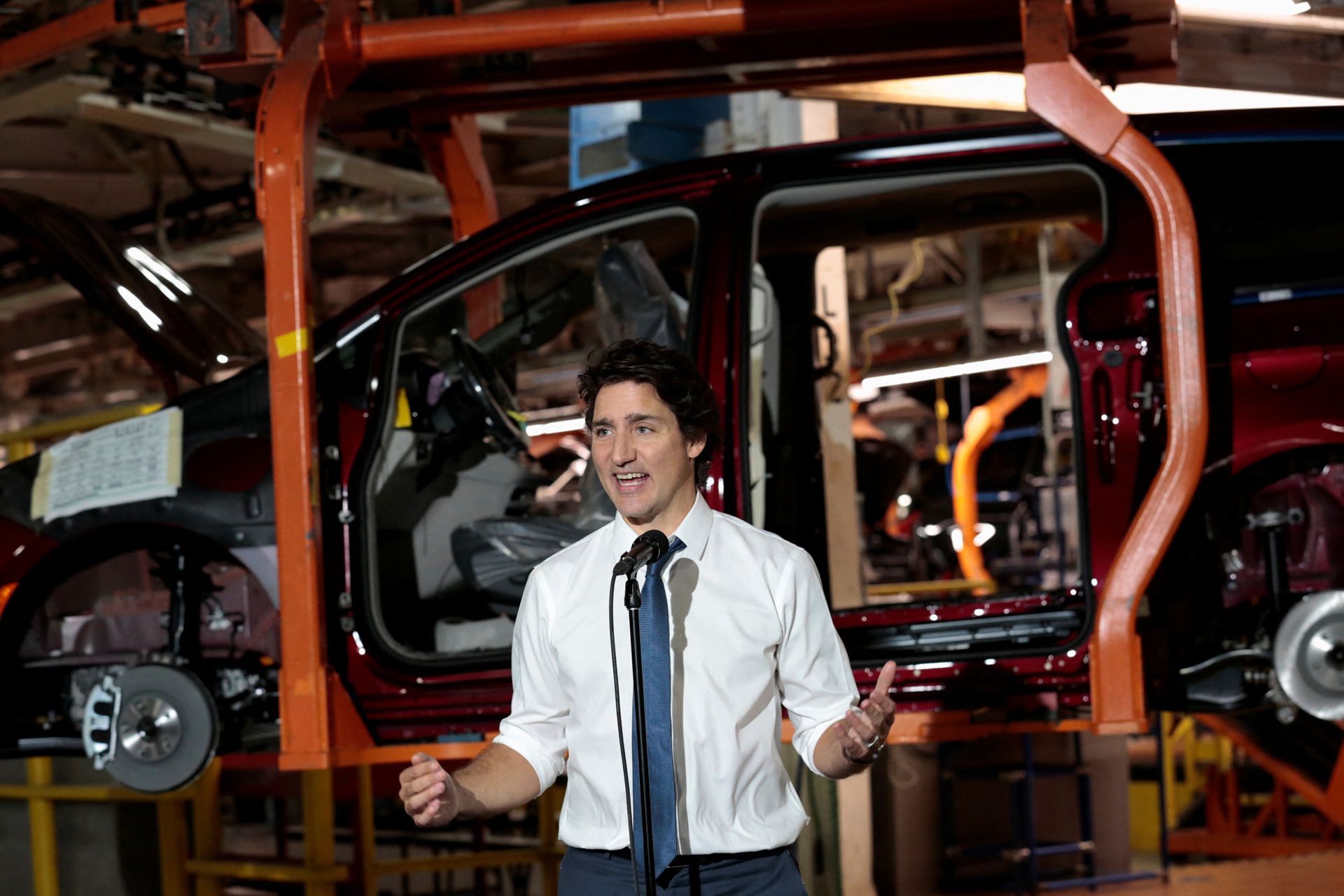Why the Canadian and Ontario governments keep throwing more money at the EV industry—and why it might not work out

Article content
So, we now know how much it will cost to keep Stellantis in Canada. Or, at least, we think we know, since various sources are quoting different numbers of billions: the CBC says $15 billion; the Toronto Star $16 billion; and our own Financial Post once estimated that it would take a whopping $19 billion to keep the Stellantis-Samsung battery plant in Windsor.
Advertisement 2
Article content
Whatever the case, it’s a big bunch of bucks, and, though Motor Mouth has already covered this particular crisis — and the American Inflation Reduction Act (IRA) that precipitated it — the numbers are sufficiently large to warrant a discussion of how we got here, where our money is being spent, and, most importantly, how long we’re going to have to keep paying.
How we got here
All the billions being bandied about are the result of president Joe Biden’s Inflation Reduction Act. Ostensibly penned to reduce the impact that inflation is having on the U.S. economy, in reality it is nothing more than a protectionist money-dump aimed at America’s bogeyman du jour, China, and that country’s immense lead in producing electric vehicles.
Advertisement 3
Article content
To that end, the U.S. government has decided to subsidize the domestic production of batteries to the tune of US$45 per kilowatt-hour — US$35 for the battery cells; US$10 for building those cells into a module — on an ongoing basis. That means a 45-gigawatt-hour battery-assembly plant — like that Stellantis is proposing — built in America is eligible for roughly US$2.0 billion per year. Each and every year, in fact, until 2032. Hence, that big bunch of billions. Estimates of the total cost of these subventions to the American taxpayer extend all the way to US$300 billion.
-
Motor Mouth: Stellantis pulling out of Ontario battery plant
-
Motor Mouth: When woke economics meets EV pricing
How we got here
By now, it should be obvious to one and all that, if Canada wanted to get in on some of this battery manufacturing largesse — and Lord knows the federal Liberals are more than anxious to virtue-signal their environmental bona fides — it would have to match the monies the U.S. was willing to pony up to attract automakers to its shores. Thus did Volkswagen get an initial $700 million — in traditional, up-front grants to literally build its plant — and then the now-controversial $13.2 billion in ongoing tax breaks that mirror the IRA’s largesse. Essentially, monies VW would have been eligible for had it built its PowerCo plant south of the border have been promised by federal innovation minister François-Philippe Champagne.
Advertisement 4
Article content
And that is when the feces hit the proverbial fan. You see, less than six months beforehand, Stellantis and LG Energy Solution made a deal with the federal and Ontario provincial governments to build a battery plant in Windsor, and, while it is reported they may have secured more money — up to $1 billion — in upfront grants, because President Biden had yet to sign the IRA, they were not offered that ongoing US$45/kWh subsidization.
Thus did we endure 60 or so days of we’re-putting-our-shovels-down-dammit crisis as Stellantis threatened to pack up shop and move to the U.S., where those $15 billions, $16 billions, or $19 billions are all but automatic.
Ontario gets screwed
If the Toronto Star is right in its assessment of how the deal went down, it would appear that, of the ongoing per-kilowatt-hour subsidies, the federal government is kicking in $10 billion, and the Ontario Conservatives another $5 billion. This is actually quite noteworthy — and, if I’m a provincial premier, pretty scary — since these are supposed to be uniquely federal costs.
Advertisement 5
Article content
In the U.S., all the IRA monies are supplied by the feds, which means the costs for the assembly plants built — be they in Michigan or South Carolina — will be borne equally by taxpayers throughout the 50 states. It also appears — or, at least, we have no information to the contrary — that the $13.2 billion in IRA-matching tax breaks offered to Volkswagen all came from our federal coffers.
The point is the American Inflation Reduction Act is trying to buy its way to cost-competitiveness on the backs of taxpayers
However, with Premier Doug Ford strong-armed — by Minister Champagne — into paying for a third of that reported $15 billion, that means Ontario taxpayers will be paying doubly on their tax returns to subsidize Stellantis for the next nine years or so. Yes, provincial — and state — taxpayers are often on the hook for up-front benefits ladled on automakers, but as far as I know, this is the first time it has been applied to IRA, or IRA-like, ongoing subsidies.
Advertisement 6
Article content
That, from a taxpayers’ point of view, may not be the worst news, however. The even bigger question, especially for those aforementioned taxpayers, is—
Will we ever be able to stop subsidizing EVs?
The IRA in its current form is due to run until 2032 — the last years at reduced levels of subvention — and although America’s current federal US$7,500 consumer subsidy is relatively new, California started subsidizing electric vehicles in 2010. Ditto for Ontario, with Quebec starting in 2012. That means, despite many protestations over the years to the contrary that electric vehicle subsidies would be just temporary — and that EVs’ price parity with ICEs was just around the corner — subventions, in one form or another, will have lasted more than 20 years by the time the IRA runs out. Indeed, thanks to the IRA, rather than being phased out, the monies ladled on automakers otherwise reluctant to build EVs — and consumers otherwise reluctant to buy them — has been magnified to levels previously unimaginable.
Advertisement 7
Article content
More troubling, however, are a couple of reports that question whether anyone will ever be able to compete on an even footing — i.e. without subsidization — with China. The first is a report from Le Figaro in France claiming that Stellantis CEO Carlo Tavares opined that in mandating electric vehicles so quickly, the E.U. might as well as be rolling out a “red carpet” for Chinese automakers. And indeed, though Chinese EVs are yet to have a presence in North America, they are starting to make in-roads in Europe.
China’s lead in EV production is humongous
Emphasizing that advantage is another recent report — this time by Reuters — that says that “China has a 10,000-euro cost advantage in small EVs.” That is, at current exchange rates, equivalent to US$10,883, or CDN$14,480, which would seem an insurmountable lead, one that apparently dooms mainstream European automakers. Reuters cites Forvia Chief Executive Patrick Koller as saying “Chinese EV makers can produce vehicles for less because they have lower research and development costs, lower levels of capital spending, and lower labour costs than rivals in Europe,” not to mention several technological and supply-chain advantages.
Advertisement 8
Article content
Though we in North America — both Canada and the United States — are probably in more competitive positions, it remains that China has a substantial lead in low-cost EV production. In fact, according to Reuters, while the average cost of an electric vehicle in Europe since 2015 has risen from 48,942 euros to 55,821 euros — and from the equivalent of a whopping 53,038 euros to 63,864 euros in the United States! — Chinese automakers have found a way to reduce their average price from 66,819 euros to 31,829 euros in the same time-frame.
Nor does there seem much hope that either Europe or North American manufacturers can bridge that gap. Even if they could overcome, say, CATL’s leadership in low-cost battery chemistry — the company boasted a breakthrough in low-temperature charging just as we went to press — and open up some source of rare-earth metals, there’s no way to match China’s dramatically lower labour costs, which, even with electric vehicles’ reduced componentry, still account for more than a quarter of the cost of a new car.
Advertisement 9
Article content
Nor have we made much of an attempt reducing those costs. Tesla has been promising cheap battery power for so long that even the most ardent cultists have lost faith. The domestics, meanwhile, are so busy building 200-kilowatt-hour pickups — for which the batteries cost and weigh more than an entire Chinese car — that they’ve ignored entry-level EVs. Even our governments have contributed to the inflation of new car prices, continually raising the MSRP eligibility limits for consumer EV incentives to accommodate automakers making ever more expensive vehicles.
I suspect, for instance, that General Motors’ promise of a US$30,000 Chevrolet Equinox by this fall relies heavily on this subsidization. For one thing, said promise was made last year when battery manufacturing costs — before subsidizations — were about 30 per cent cheaper than they are today.
Advertisement 10
Article content
Furthermore, more than a few people suspect that The General had advance knowledge of President Biden’s then-impending IRA announcement. Does that mean — and, a hint here: damned straight it does — that CEO Mary Barra’s promise factors in the monies the IRA’s clause 45X puts towards its battery? An Equinox will require, at bare minimum, a 60-kWh battery, which means there’s almost US$3,000 of federal monies in GM’s coffers before the consumer even steps up to the plate.
The point is that the American Inflation Reduction Act — and, of course, our acquiescence to it — is trying to buy its way to cost-competitiveness on the backs of taxpayers. The question even bigger than “should we be doing this?” then, is whether we can ever get out from under this rock. Subsidies have traditionally been meant to be temporary market distortions to allow a burgeoning technology to find its feet. There remains no sense of temporariness to the money we are throwing at electric vehicles.
Stay connected with us on social media platform for instant update click here to join our Twitter, & Facebook
We are now on Telegram. Click here to join our channel (@TechiUpdate) and stay updated with the latest Technology headlines.
For all the latest Automobiles News Click Here


Comments
Postmedia is committed to maintaining a lively but civil forum for discussion and encourage all readers to share their views on our articles. Comments may take up to an hour for moderation before appearing on the site. We ask you to keep your comments relevant and respectful. We have enabled email notifications—you will now receive an email if you receive a reply to your comment, there is an update to a comment thread you follow or if a user you follow comments. Visit our Community Guidelines for more information and details on how to adjust your email settings.
Join the Conversation